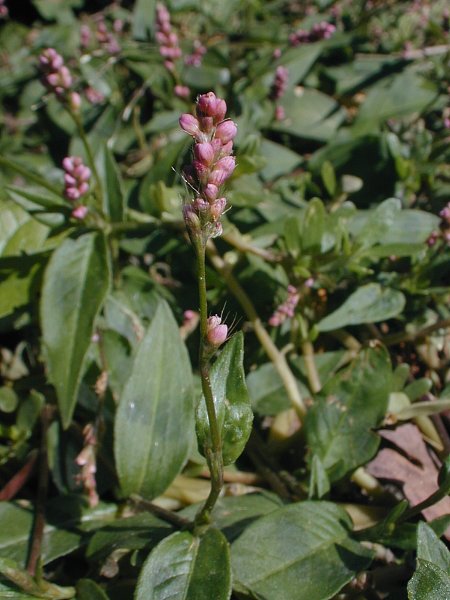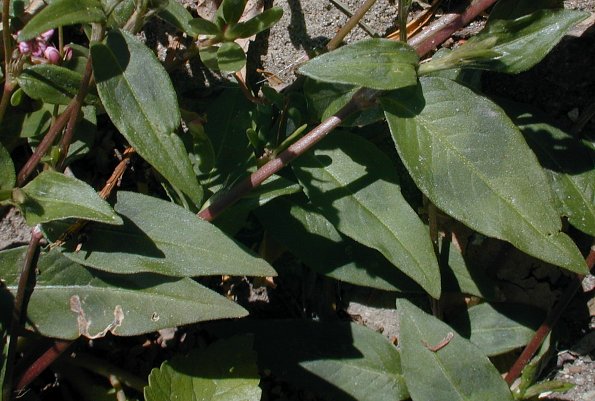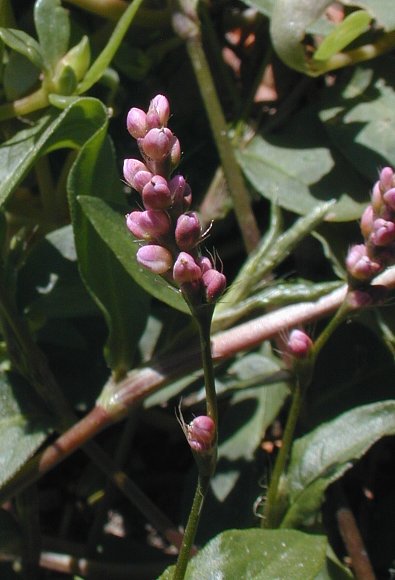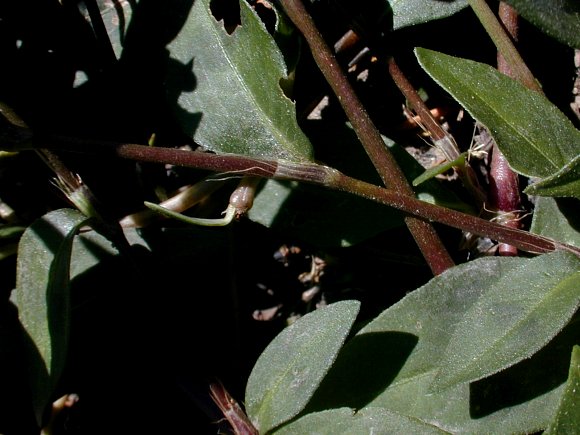Description: This summer annual plant has stems up to 2' long that tend to lie along the ground, although their tips are more erect (i.e., they're decumbent). A robust plant often branches near the base, sending decumbent stems in all directions. The stems are light green to reddish brown, round in circumference, and glabrous. The alternate leaves occur at interval along these stems; they are up to 3" long and 1" across, tapering to a petiole-like base. These leaves are elliptic, broadly lanceolate, or ovate in shape, smooth along the margins, and hairless (or nearly so). Some leaves may have a faint black smudge toward the middle of the upper surface. At the base of each leaf, there is a membranous sheath (ocrea) with long bristles along its upper rim; sometimes these bristles are as long as the sheath.

The outer tips of the stems terminate in spike-like racemes of flowers up to 1½" long and 1/5" (5 mm.) in diameter. Each small flower is about 1/8" (3 mm.) long, consisting of 5 pink to rosy pink sepals and no petals. At the base of each flower (or group of flowers) along the raceme, there is a small sheath with long bristles (i.e., a bristly ocreola); these bristles can be longer than the flowers. The blooming period occurs during the summer and early fall, and can last 2-3 months for a colony of plants. Each flower is replaced by a 3-angled seed that is black and shiny, tapering to blunt points at the upper and lower ends. The root system consists of a taproot that is shallow and branching. This plant can reproduce vegetatively by forming rootlets near ochreae of the leaves; more often, it reproduces by reseeding itself.

Cultivation:
This
weedy plant isn't fussy about growing conditions. It can be found in
full sun to light shade, moist to dry areas, and various kinds of soil,
including those containing loam, clay loam, and rocky or gravelly
material. Some of the lower leaves may shrivel away during hot dry
weather. This smartweed withstands regular lawn-mowing better than
others because of its low-growing habit.
Range & Habitat:
The non-native Creeping Smartweed is locally common in some urban areas
of NE
Illinois, otherwise it is widely scattered and uncommon (see Distribution
Map). This plant is adventive from SE Asia and was originally
collected in Illinois during the 1940's. It is probably spreading to
new areas in the state. Habitats include lawns, edges of yards,
roadsides, cracks of sidewalks, vacant lots, weedy stream banks, and
waste areas. As can be
inferred from these habitats, Creeping Smartweed is found primarily in
disturbed areas of cities, particularly in old residential
neighborhoods and abandoned or declining business districts.

Faunal
Associations:
The flowers of smartweeds (Persicaria
spp.) attract various insects, including
short-tongued bees, wasps, flies, small butterflies, and skippers. The
caterpillars of some Copper butterflies and many moths feed on the
foliage, while the caterpillars of the butterfly Strymon
melinus (Gray Hairstreak) eat the developing seeds. Other
insects that eat the foliage include Systena frontalis
(Red-headed Flea Beetle) and Popillia japonica
(Japanese Beetle). Some small mammals eat the seeds of upland
smartweeds and knotweeds, including the Thirteen-lined Ground Squirrel
and White-footed Mouse. Birds of urban habitats that are likely to eat
the seeds of Creeping Smartweed include the Mourning Dove, English
Sparrow, House Finch, and other granivorous songbirds.
Photographic Location:
Along a sidewalk near the Champaign County Courthouse in Urbana,
Illinois.

Comments: The decumbent habit and bristly ochreolae of the flowers make this smartweed fairly easy to identify. Other smartweeds in the state are more erect in habit (except the 'Tearthumb' vines), and their ochreolae have bristles that are always shorter than the flowers, or they are lacking such bristles altogether. Creeping Smartweed (Persicaria longiseta) has other distinctive characteristics, including ochreae with unusually long bristles and leaves that are broader in shape than those of other smartweeds. Superficially, Creeping Smartweed can resemble a mowed-over Persicaria maculosa (Lady's Thumb), but this latter species lacks bristles in its ochreolae and its leaves are more slender. The spike-like racemes of Creeping Smartweed are about 4-5 mm. in diameter, while those of Lady's Thumb are more stout and exceed 5 mm. in diameter. Some authorities state that the leaves of Lady's Thumb have black chevrons or smudges on their upper surface, while the leaves of Creeping Smartweed are lacking such markings, but this distinction is not always reliable. Other scientific names of Creeping Smartweed are Persicaria caespitosa, Persicaria cespitosa, Polygonum longisetum, and Polygonum caespitosum longisetum.